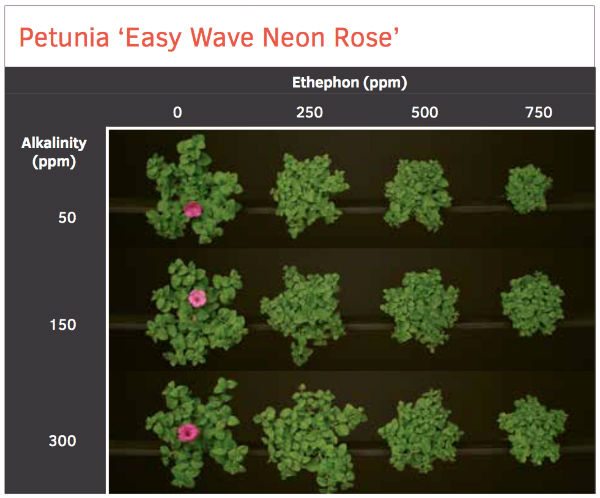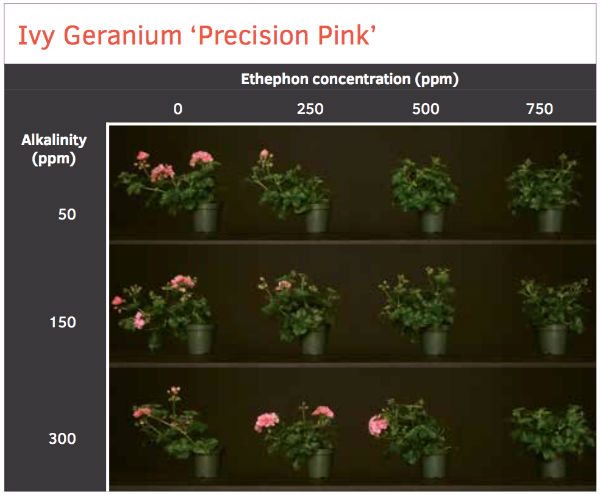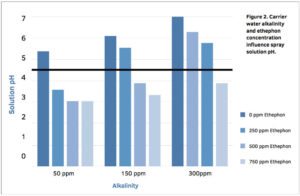Enhancing Your PGR Applications — Part 1
Do you plan to use plant growth regulators or retardants (PGRs) on your spring crops? Did you know that the pH of the spray solution and air temperature at application can influence the efficacy of some PGRs? In this two-part series, we will show you how to save time and money, by monitoring and adjusting two often overlooked cultural and environmental factors that can influence PGR efficacy.
In order to increase plant densities, meet market or buyer specifications, and produce compact and aesthetically pleasing plants, greenhouse growers use a wide variety of PGRs. Many factors influence PGR efficacy including the active ingredient, use of surfactants, chemical concentration and volume applied, solution pH, and environmental conditions (such as humidity, air movement, light and temperature at application).
In this article, we will focus on how spray water alkalinity affects the efficacy of three commonly used PGRs. In the next article, we will discuss how to manage air temperatures to maximize PGR spray results.
GA Biosynthesis Inhibitors

The most commonly used PGRs are the gibberellin inhibitors (also referred to as gibberellic acid or GA). These PGRs control extension growth (i.e., plant height) by inhibiting various steps in the biosynthetic pathway of gibberellins, the plant hormone responsible for cell elongation. Plant growth retardants with active ingredients of ancymidol (i.e., A-Rest or Abide), chlormequat chloride (i.e., Cycocel, Citadel, or Chlormequat E-Pro), daminozide (i.e., B-nine or Dazide), flurprimidol (i.e., Topflor), paclobutrozol (i.e., Bonzi, Piccolo, Paczol or Downsize), or uniconazole (i.e., Sumagic or Concise) are all GA inhibitors.
Other PGRs
The PGRs Fascination and Fresco contain two forms of GA (GA4 and GA7) plus the synthetic cytokinin benzyladenine (BA). These PGRs are used to counteract over application of one of the previously mentioned GA inhibitors or suppress lower leaf yellowing.
Another PGR, ethephon [i.e., Florel (3.9 percent active ingredient) or Collate (21.7 percent active ingredient)] can also be used to inhibit stem elongation, abort flower buds and flowers, and promote lateral branching. Ethephon [(2-chloroethyl) phosphonic acid] is a compound that breaks down to release the gas ethylene. This PGR is only labeled for spray applications, although research shows that it can also be effective as a drench.
Alkalinity and PH
The pH of the carrier water used to mix many of the chemicals used in agriculture can influence their efficacy. One example we should all be familiar with is ethephon. As ethephon is mixed with carrier water to make a spray solution, it converts into the gaseous and active form ethylene. At a low pH (4.5 or below), ethephon is stable and ethylene is not released. As pH increases, ethephon breaks down into ethylene more quickly. Therefore, the goal is to keep it in the liquid form until it is inside the plant.
One way to keep ethephon in its liquid form longer is to manage the pH of the solution. Therefore, the goal for ethephon sprays is to keep the solution pH below 4.5. Ethephon is naturally acidic, so this is normally not a problem. However, if the carrier water has a high alkalinity (CaCO₃), the pH may not decrease enough to fall below 4.5. Once the chemical is absorbed by the plant, the plant’s more neutral pH will cause the ethephon to change to ethylene. Additionally, the recommended spray solution pH for uniconazole and GA₄₊₇/BA spray solutions is 5.5 to 6.5.

The Study
We conducted a series of experiments to investigate how carrier water alkalinity affects the efficacy of ethephon, uniconazole, and GA₄₊₇/BA spray solutions applied to various greenhouse crops. In all of the experiments, we adjusted the Michigan State University (MSU) greenhouse tap (carrier water) water to 50-, 150-, or 300-ppm CaCO₃ by adding sulfuric acid. Alkalinity was measured by using a Hanna Alkalinity Colorimeter (Figure 1).
Ethephon. The adjusted carrier water (50-, 150- and 300-ppm CaCO₃) was mixed with ethephon (Collate, Fine Americas) to create 0-, 250-, 500- and 750-ppm ethephon solutions. Rooted cuttings of verbena ‘Aztec Blue Velvet’ and ivy geranium ‘Precision Pink’, and plugs of petunia ‘Easy Wave Neon Rose’ were transplanted into 4-inch containers. Once roots reached the sides of the containers, the plants were sprayed 14 and 23 days after transplant. For the second replication of the study, rooted cuttings of New Guinea impatiens ‘Clockwork Purple’ and zonal geranium ‘Fantasia Pink’ along with verbena, ivy geranium and petunia were sprayed with the same ethephon solutions seven, 10 or 14 days after transplant depending on species and when the roots reached the edge of the container.
Uniconazole. The adjusted carrier water (50-, 150- or 300-ppm CaCO₃) was mixed with uniconazole (Concise, Fine Americas) to create 0-, 7.5, 15-, or 30-ppm uniconazole solutions. Plants from the five species previously mentioned were sprayed 14 days after transplant.
GA₄₊₇/BA. Plants were sprayed 14 days after transplant with a solution containing 30-ppm uniconazole (carrier water alkalinity of 150-ppm CaCO₃). Twenty-one days after the uniconazole spray, the plants were sprayed with a solution containing 0-, 1/1-, 5/5- or 10/10-ppm GA₄₊₇/BA (Fresco, Fine Americas) with carrier water alkalinities of 50-, 150- or 300-ppm CaCO₃.

What Did We Learn About PH?
Ethephon itself is acidic; therefore, as you increase the ethephon concentration, the solution pH decreases. Additionally, as your carrier water alkalinity decreases, your solution pH decreases (Figure 2). The addition of uniconazole or GA₄₊₇/BA to the carrier water did not significantly affect the solution pH. Therefore, carrier water pH can be changed and adjusted without having to account for a change in pH.
How Does Carrier Water Alkalinity Influence PGR Efficacy?
We determined that there was an interaction between carrier water alkalinity and ethephon concentration (Figures 3 and 4). Understanding this interaction can help you maximize spray efficacy and potentially reduce PGR rates or the number of applications. For example, a grower in the Midwest may have carrier water with an alkalinity of 300-ppm CaCO . They decide to spray their petunia crop with 500-ppm ethephon. If they reduce the alkalinity of their carrier water to 50-ppm CaCO₃, they can significantly reduce extension growth (Figure 4). Alternatively, if the grower was happy with the results provided by the combination of 300-ppm CaCO₃ and 500-ppm ethephon, they could cut the ethephon rate in half if they reduced the carrier water alkalinity to 50-ppm CaCO₃ (Figure 4). To determine the alkalinity of your carrier water, simply send water samples to a lab or use a hand-held meter (Figure 1).
Increasing concentrations of uniconazole reduced the height of zonal geranium while increasing GA₄₊₇/BA increased the stem length of verbena. Efficacy of uniconazole and GA₄₊₇/BA on these two crops was slightly reduced with increased carrier water alkalinity, but the reduction was not commercially significant. The uniconazole rates used in the study were effective in controlling the growth of New Guinea impatiens, petunia, and verbena, while GA₄₊₇/ BA sprays resulted in increased extension growth of petunia, New Guinea impatiens and verbena, and their efficacy was not affected by spray water alkalinity.
Take Home Message
If you use ethephon, we recommend that you check the alkalinity of your carrier water before mixing. This can be done by sending a water sample to your preferred lab or testing your carrier water with a hand-held alkalinity meter (Figure 1). If your carrier water alkalinity is too high, you may need to add a buffering agent such as an acid (i.e., sulfuric acid) or adjuvant (i.e., pHase5 or Indicate 5) to lower the alkalinity and final solution pH. Next, add ethephon and check the pH of your spray solution with a hand-held pH meter to ensure that it is below 4.5. Carrier water alkalinity does not appear to have a large effect on uniconazole nor GA/BA sprays.
As always, perform in-house trials to evaluate the effectiveness of PGRs on plants produced under your growing conditions.



 Video Library
Video Library 




















